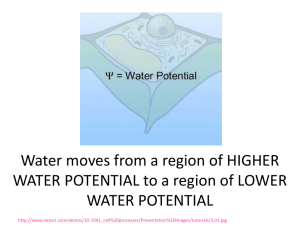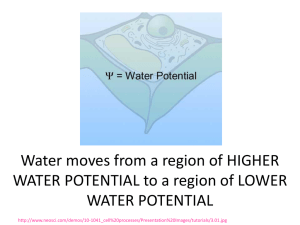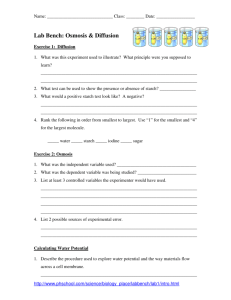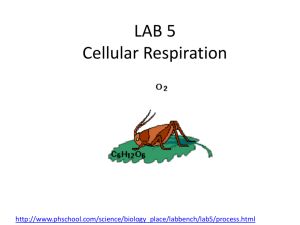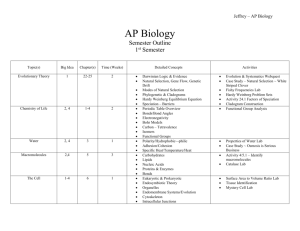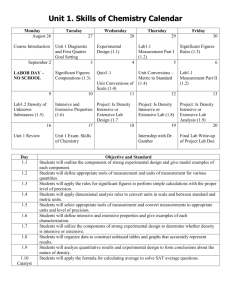Pre-lab preparation for the OsmosisDiffusion lab
advertisement
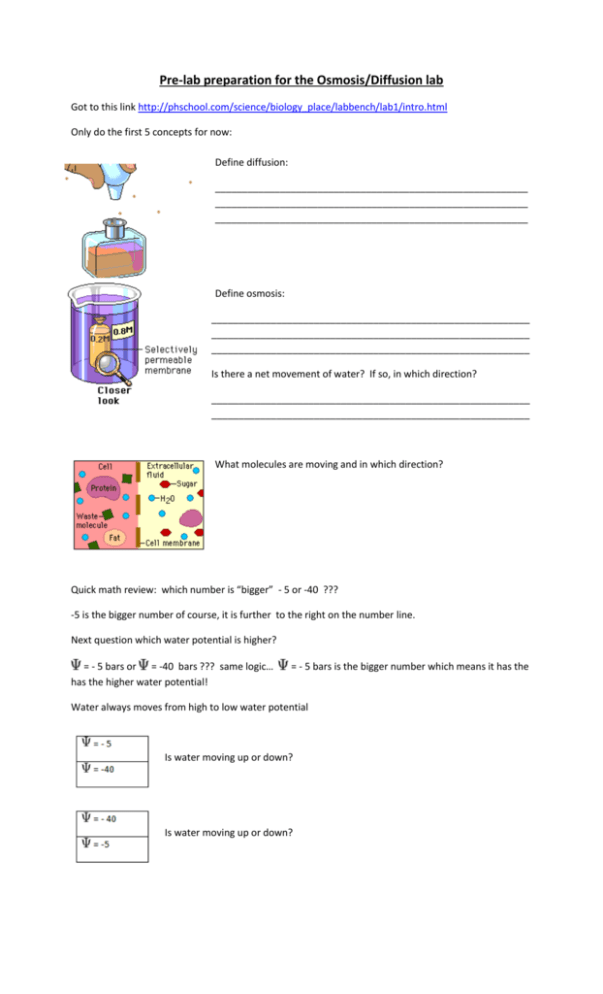
Pre-lab preparation for the Osmosis/Diffusion lab Got to this link http://phschool.com/science/biology_place/labbench/lab1/intro.html Only do the first 5 concepts for now: Define diffusion: __________________________________________________________ __________________________________________________________ __________________________________________________________ Define osmosis: ___________________________________________________________ ___________________________________________________________ ___________________________________________________________ Is there a net movement of water? If so, in which direction? ___________________________________________________________ ___________________________________________________________ What molecules are moving and in which direction? Quick math review: which number is “bigger” - 5 or -40 ??? -5 is the bigger number of course, it is further to the right on the number line. Next question which water potential is higher? = - 5 bars or = -40 bars ??? same logic… has the higher water potential! = - 5 bars is the bigger number which means it has the Water always moves from high to low water potential Is water moving up or down? Is water moving up or down? One way of thinking of this is to consider the solvent concentration of water. The higher the concentration of water: the higher its water potential. Pure water has a water potential of zero, it never gets higher than that! Start diluting water with solute and the water potential decreases, becomes more negative as it slides left along the number line. That is why almost all free-living cells (except for animals) have cell walls. If the inside of the cell has a negative pressure, i.e. - , then water is moving into the cell. To prevent the cell from blowing up, an opposing pressure must be exerted. That second pressure must be a positive pressure, i.e. + Think of the cell wall as a mechanical device “squeezing” water out of the cell. If the cell in the diagram above were in pure water, which direction water would water be moving moving? Explain using symbols _______________________________________________________ _____________________________________________________________________________________ If sufficient water moves into the cell, what happens to the value of ? _______________________ ____________________________________________________________________________________ When is the net movement of water equal to zero? Explain using symbols _____________________ _____________________________________________________________________________________ Remember that when you check out the following video: http://www.youtube.com/watch?v=nDZud2g1RVY Stop the video when you see this equation: ( ) = –iCRT OK take a deep breath - That equation is really not too scary! Go to the following link: http://phschool.com/science/biology_place/labbench/lab1/watpot.html Now you understand while almost all free-living cells have cell walls! Explain why cell walls are important for free-living cells: _______________________________________________________________ _______________________________________________________________ Explain what is happening using the terms “hypotonic “ & “hypertonic” _________________________________________ _____________________________________________________ _____________________________________________________ ____________________________________________________ You should be on this link to answer this question: http://phschool.com/science/biology_place/labbench/lab1/watcalc.html Here is the definition of Water Potential Water potential ( ) = solute potential ( ) + pressure potential ( ) When Water potential ( ) is negative, is water moving into or out of the cell? Explain ______________________________________________________________________________ ______________________________________________________________________________ 1 bar = approximately _____________________________________________. There are two components to water potential: solute concentration and pressure. How do you think this fact affects the movement of water into and out of cells? For example, can two solutions that differ in their solute concentration be at equilibrium in terms of water movement? Can a solution with a molarity of 0.2 be in equilibrium with a solution with a molarity of 0.4? Explain your answer: ___________________________________________________________________ _____________________________________________________________________________________ _____________________________________________________________________________________ _____________________________________________________________________________________ Here is a diagrammatic representation of should have been your answer above. OK – now we are ready to do calculations involving water potential. They are quite easy actually, little more than plugging values into a formula is all. You will not be expected to memorize the formula. You only need to know what the symbols mean. Proceed to this link: http://phschool.com/science/biology_place/labbench/lab1/watcalc.html Define the symbols found on http://phschool.com/science/biology_place/labbench/lab1/analysis.html OK, now finish the Bozeman video: we left off at about the 5 minute mark http://www.youtube.com/watch?v=nDZud2g1RVY Sample Problem found here: http://phschool.com/science/biology_place/labbench/lab1/analysis.html The molar concentration of a sugar solution in an open beaker has been determined to be 0.3M. Calculate the solute potential at 27 degrees. Round your answer to the nearest hundredth. _______________________________________ The pressure potential of a solution open to the air is zero. Since you know the solute potential of the solution, you can now calculate the water potential. (If you need to, review the equation for calculating water potential.) What is the water potential for this example? Round your answer to the nearest hundredth. _________________________________________ Here is a quick quiz: http://phschool.com/science/biology_place/labbench/lab1/quiz.html You are now ready for the Osmosis/Diffusion Lab!
